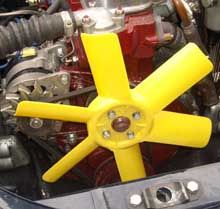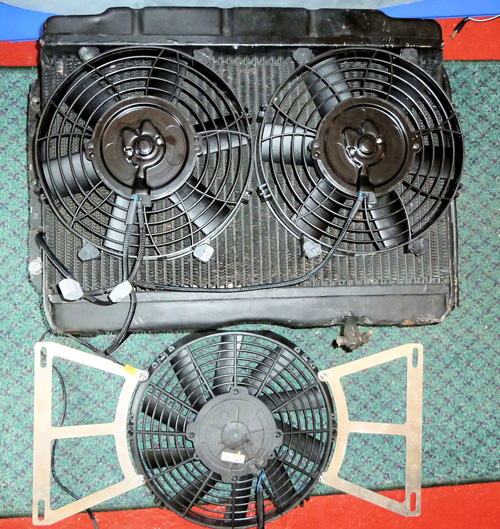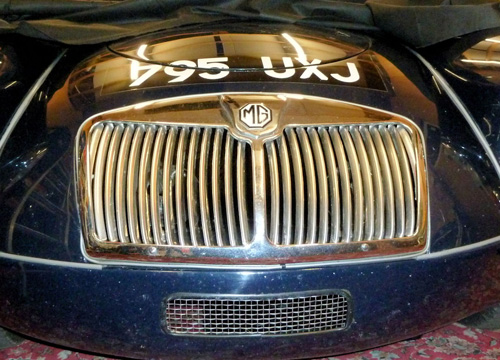Cooling! Experiments With My MGA’s Cooling System – Part 2

 Part 1 of this article featured Colyn’s experiments with a variety of plastic fans. In this article, he explores electric fan alternatives as his quest continues.
Part 1 of this article featured Colyn’s experiments with a variety of plastic fans. In this article, he explores electric fan alternatives as his quest continues.
SINGLE ELECTRIC FAN
I almost ordered a seven-blade Moss fan but then, just as I was going to do this, it happened again, “I read in the forums” about Lindsay Sandford’s experiences with a single 10” diameter electric fan made by Revotec. This appeared to control his MGA’s water temperature without a mechanical fan being fitted. Lindsay had also noticed a slight increase in engine performance too without the mechanical fan; and it was this observation, which persuaded me to give the Revotec fan a try.
I sent for the Revotec MGA fan kit late in spring 2012, but I decided not to fit it until after our Alpine trip in the summer of that year. It was actually summer in 2013 that I eventually got around to fitting it. Firstly, I removed the NTG fan so that I could try cooling the car using only the single electric fan.
The Revotec kit includes some beautifully made alloy brackets that fit onto six extra-long radiator-mounting bolts in front of the radiator. They are a little awkward to fit, especially the lower ones as my car has the oil cooler’s thermostatic valve fitted onto the bulkhead next to the radiator. The kit also comes with a custom-made alloy thermostatic control unit, which fits between two specially moulded extra-short top hoses. The control unit has a small temperature adjustment screw, which allows you to set the temperature that you wish the fan to cut in at. Just for peace of mind, I fitted a manual over-ride switch for the fan to be able to switch it on, if I thought that the control unit wasn’t quite set at the correct temperature.

I connected the power supply for the fan directly from the starter switch using a 20-amp in-line fuse. I did consider connecting it through the ignition switch so the fan would switch off when the engine was stopped, but I decided against this to prevent overloading the switch.
It was a fairly warm day (for the UK) when I tried it for the first time, approximately 23 degrees C (73 F). I let the car just tick-over to begin with to check for leaks, but I must admit to being really surprised at just how quickly the engine temperature climbed, probably a factor of two to three times quicker than it did with a standard engine driven fan fitted. When the temp reached 185, the fan cut in and the temperature slowly dropped down; and within a few minutes it dropped to 170 degrees and switched off. So there was a 15-degree difference between switching on and switching off. I left the car ticking over for quite some time and the fan repeatedly cooled the engine down with no problem, although I would have preferred it to cool things down a little quicker.
I also noticed that there was none of the slightly rougher idling that would normally occur on long periods of tick-over when the engine driven fan was fitted. So, the movement of air through the under bonnet space seemed to be keeping the float chambers cooler than usual, which was encouraging. I did notice though that when driven on the road, the running temperature had increased by approximately 10 degrees to 185 degrees (as compared to 175 degrees with the plastic NTG engine driven fan). This shows just how much constant cooling effect an engine driven fan has.
Unfortunately, this also meant that the coolant temperature never really dropped far enough for the thermostatic control to stop the fan from running continuously, which definitely wasn’t in the plan! To prevent this, I increased the setting of the control unit to 195 degrees so that it would cut off at 180 degrees and then tried the set up for a couple of months over the summer.
It seemed to cope fairly well, but overall I was a little un-nerved by the higher than usual running temperatures that the gauge was showing, up to 200 degrees at times, especially on long fast runs, climbing steep hills and in traffic jams. I also found that I was tending to use the over-ride switch quite regularly, for example when I was driving into slow traffic and I found that switching the fan on early would help to prevent the temperature from climbing too high. Ideally I had hoped that the fan would only cut in when the car was stationary or being driven slowly through towns etc.; but I found that it often came on when the car was being driven at 30 mph, probably due to reduced airflow through the radiator. I was beginning to wonder if maybe using a single electric fan would not quite provide enough cooling for the MGA and I was considering refitting the NTG fan.
TWIN ELECTRIC COOLING FANS
In early 2014 I once again read another article in one of the forums written by Neil Ferguson in Australia a couple of years earlier. He had fitted two 9” fans, side by side, onto the front of the radiator and was running this set-up in the hot Australian summer with no mechanical fan fitted. He found that his engine temperatures were being kept under control even in that very hot environment. So I thought if this worked over there, surely it should provide plenty of cooling for our British summers.
I searched on the Internet for the 9” Davies-Craig fans that he had fitted and found a supplier here in the UK. They were actually quite a reasonable price, so I thought it was worth trying them before giving up on electric fans altogether. As Neil de scribed in his article, the twin 9” fans fit perfectly side by side under the top tank on the radiator and they look as if they could have been custom made for the MGA as they cover the full width of the radiators cooling fins.
To fit the fans, I removed the radiator, which made it a really easy job, and I used simple pull through plastic fasteners to clip through the radiator and hold the fans very securely against it. The fans are quite slim, the blades are reversible, and so it would actually be possible to fit one fan as a pusher in front of the radiator and one behind it as a puller, staggered so they don’t overlap. I may actually try this sometime.
USEFUL TIP
I found out by mistake that once the radiator is back in place with the fans fitted, there is no longer enough space to re-install the fresh air pipes, so I had to remove the grille to replace them. If you don’t want the hassle of refitting the grille, then try to remember to get the pipes into place before you fit the radiator.
I retained the Revotec control unit to operate the fans, but I replaced the fuse with a larger 30 amp one. Each Davies-Craig fan normally draws five amps when running, but this spikes up to as much as 12 amps on initial start-up, so I thought the 30-amp fuse would be ideal. I already run an alternator on my car and this can easily cope with the extra 10-amp demand, but I think a generator would still be okay with the twin fan set up, especially if the fans are not running constantly.
TRYING OUT THE TWIN FANS
Next I started up the engine and waited. As usual with no mechanical fan, the warm up time was very fast and the water temperature rapidly reached 195 degrees when the fans started up. I was delighted that you could then actually see the needle on the temperature gauge moving downwards and the fans switched off after about a minute when the temp dropped to 180. So there was plenty of airflow through the radiator and the twin-fans were easily able to control the temperature. I opted to live with the twin-fans through the spring and early summer to see how they worked out and I could then decide whether or not to risk using them on a planned trip to climb the Pyrenees.
Also, I should add that before this trip, I finally got around to re-adjusting the slats on my repro grille to open them up to the original gaps. Before I did this they were almost closed up! This alone appears to have dropped the running temp down by five degrees F and has probably helped the twin fan project.

I noticed that in the UK the engine temperature was normally somewhere in the region of 175 to 185 degrees, and I found that if I set the control unit to switch on at 200 degrees, the fans would hardly ever operate. They would only switch on when the car stood idling or when crawling along in very slow traffic.
I decided to leave the twin-fans on the car for our Pyrenean traverse, which was scheduled for late July-early August. The ambient temperature would be up in the high 90s and there were going to be many long climbs over high mountain passes (some up to 9,000 ft) on the way, but I was confident that the twin-fans would cope. I must admit that I did take the NTG fan with me in the boot just in case this confidence was ill founded!
During the trip, the twin-fans worked really well, although they did come on a few times whilst on the long fast motorway run down to the Mediterranean. This only happened on a couple of long 80 mph climbs in temperatures of almost 100 degrees, which was pushing things a little. I then re-set the control unit up to 208 degrees and this seems to have done the trick; the engine only reached this temperature when it was stationary, but the fans rapidly dropped it to 193 when the fans switched off. In the higher ambient temperatures in the Mediterranean Pyrenees, even when climbing the long mountain passes, the engine usually ran at between 185 to 190 degrees at the most, and so I found that as long as the car was moving, the fans stayed off.
CONCLUSION
I have decided to leave the twin-fan set up in place now that it is working so well, and I can feel a very slight improvement in performance now that the engine driven fan has been removed. However, I have not really checked to see if the fuel consumption has improved, probably because I must admit that I never drive the car in an economic way. The only thing I would like to change on this set up is to swap the thermostatic control unit for one which would have a smaller gap between the on and off setting. Ideally, I would like one that has an adjustment for both the on and the off temperature and if such a switch was available, I would probably set it to switch on at 205 degrees and switch off at 195 degrees. This would keep the temp from getting too high because, even though I understand that the boiling point of the pressurized coolant is about 230 degrees, like most MGA owners, I start to get a little concerned when the needle approaches 212.
So overall, I am really happy with the outcome because now, when driving in the UK, my car doesn’t usually run at much over 185 degrees. This means that as long as my car is moving, the fans will be off most of the time and this is exactly the objective I have been aiming to achieve.
Another bonus is that having the two fans fitted, if one fails, there is still the other fan, which will just cope with the cooling, although it would probably have to run continuously to do this. Also, I can now confidently leave the NTG plastic fan behind in the garage.
A Note from the Author: I would like to thank Neil Ferguson in Australia and Lindsay Sandford in the UK whose ideas helped me to sort out my cooling system. I would not be comfortable if they were not given credit for their ideas, which made me start this process in the firstplace


Comment by: Steven G Smith
I am replacing my water pump and thought about installing a Hayden Rapid-Cool 10″ fan on the front of my radiator for a 1958 MGA. Has anyone installed this brand of fan and did you keep the engine driven fan? Any negatives on installing this fan? I read Colyn Firth’s experience with a twin fan (my radiator is too small for two fans) I am waiting to hear some comments before I connect the fan. Still waiting for a new water pump.
Comment by: Roy C. Sperbeck
After owning My MKII since 1968 and it has always run hot vapor lock in the summer, doing every suggested modification spending days and a lot of money the absolute with out a doubt fix was to have the exhaust header ceramic coated and the pipe under the seat inside and out by JET HOT ..It runs perfect .